Hookah foil /Shisha foil
Hookah foil, also called Shisha foil, is a consumable for smoking Arabic shisha, which is placed on the bowl to hold the charcoal.The Hookah also called Shisha originated in India and is mainly popular in Arab countries. Now there are similar hookah in Turkey, Iran and Central Asia. Hookah is a part of the tradition of Arab countries and Arab cultural life. Its smoke material is made of fruit and tar, nicotine content is very low, suitable for cafes, hotels, nightclubs, dance halls, KTV, bath centers and other leisure and entertainment places to operate. Shisha was once seen as dancing princesses and snakes. Later, it gradually spread to the Arab and was carried forward by the Arabs, becoming a common way of folk smoking tobacco.
Main categories of hookah foil
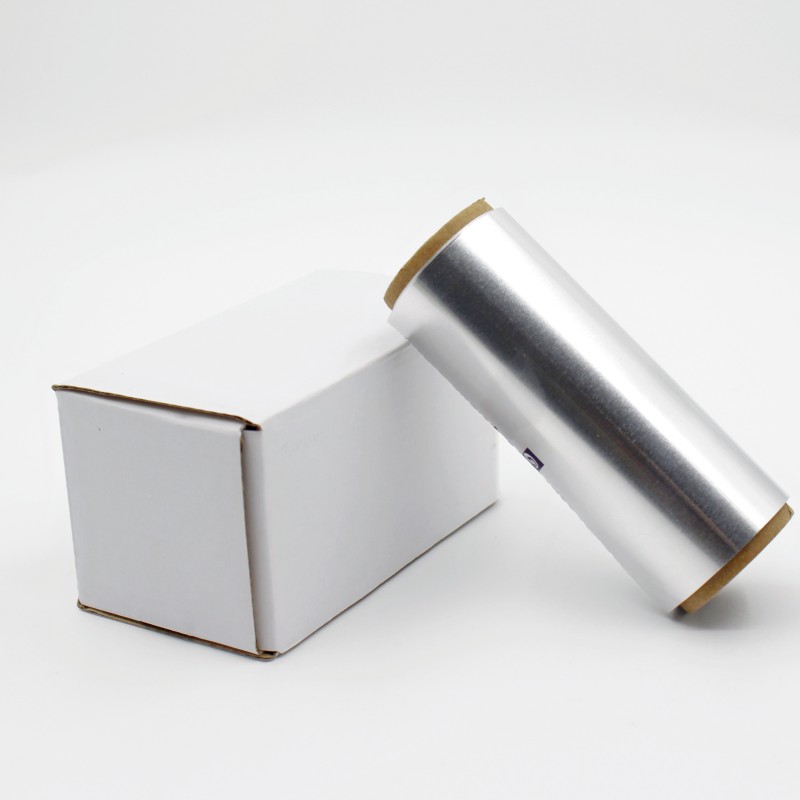
Hookah foil roll

Shisha foil sheet
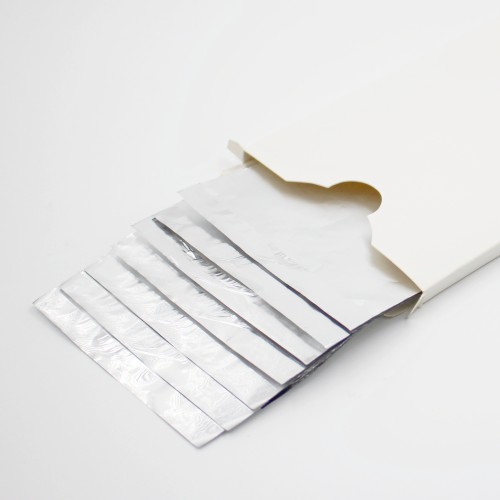
Customzied hookah foil
Hookah foil roll
Shisha foil or hookah foil rolls need to be cut when used. Generally, a square piece of aluminum foil is cut and placed on the cigarette bowl for use. For ease of use, some cigarette foil rolls have pre-cut lines and others have holes punched in them.
- Thickness : 0.012 to 0.042mm
- Width : 12cm, 15cm
- Length : 10m to 50m, customized
- Packaging : 1 roll/box, with/without blade.
Shisha foil sheet
Shisha foil pre-cut sheet are foil cutted into square or round pieces, and some are perforated. Easy to use.
- Thickness : 0.012 to 0.042mm
- Size for square sheet: 12×12cm, 15×15cm
- Size for round sheet: φ12cm, φ15cm
- Packaging : 20pcs, 50pcs, 100pcs/box
Customized hookah foil
Customizable aluminum hookah foil sheet, can be any size, thickness can be selected, and you can also choose edge folded or not.
- Thickness : 0.012 to 0.042mm
- Width : 120 to 420mm
- Length : 220m to 500m
- Edge: can be folded as request
- Packaging : 24pcs, 50pcs, 100pcs or 500/box, customized.
What you care about for hookah foils
Components of Hookah
Excluding grommets, a hookah consists of a number of components, four of which are essential for its operation.
- Bowl
Also known as the head of the hookah, the bowl is a container, usually made out of clay, marble, or glass that holds the coal and tobacco during the smoking session. The bowl is loaded with tobacco then covered by a screen or perforated hookah foil. Lit coals are then placed on top, which allows the tobacco to heat to the proper temperature.
- Vortex Bowls
Hookah bowls can often be made out of various fruits, such as by cutting a pineapple in half. The fruit is hollowed out and perforated in order to achieve the same shape and system a clay bowl has, then it is loaded and used in the same manner. Bowls have evolved in recent years to incorporate new designs that keep juices in the tobacco from running down the stem. The Tangiers Phunnel Bowl and Sahara Smoke Vortex Bowl are two examples of such bowls.
- Wind Cover
A Hookah Wind Cover is a cover that sits over the bowl area, with some form of air holes. This prevents wind from increasing the burn rate and temperature of the coal, and prevents ash and burning embers from being blown onto the surrounding environment. This may also offer some limited protection from fire as it may prevent the coal from being ejected if the hookah is bumped.
- Hose
The hose (one or more) is a slender flexible tube that allows the smoke to be drawn for a distance, cooling down before inhalation. The end is typically fitted with a metal, wooden, or plastic mouthpiece of different shapes, size, color or material type. Today, the hose proper is typically made from vinyl which allows it to be easily cleaned. According to J. S. Gamble in A Manual of Indian Timbers in 1902 (p. 668), the bark of the white Himalayan birch Betula utilis ssp. jacquemontii was used to make early hookah tubes.
- Purge valve
Many hookahs are equipped with a purge valve connected to the airspace in the water jar to purge stale smoke that has been sitting unused in the jar for too long. This one-way valve is typically a simple ball bearing sitting over a port that seals the port by gravity alone and will open if positive pressure is created by blowing into the hose. The bearing is held captive with a screw-on cover. The cover should be opened and the bearing and seat cleaned of residue and corrosion regularly to ensure proper sealing.
- Water base
Woodworkers from Damascus, Syria creating wood components for hookah production (19th century)
The body of the hookah sits on top of the water base, or sometimes referred to as vase. The downstem hangs down below the level of the water in the jar. Smoke passes through the body and out the downstem where it bubbles through the water. This cools and humidifies the smoke. Liquids such as fruit juice may be added to the water or used in substitution. Pieces of fruit, mint leaves, and crushed ice may be added.
- Plate
A plate or ashtray sits just below the bowl to catch ashes falling off the coals.
- Grommets
Grommets in a hookah are usually placed between the bowl and the body, between the body’s gasket and the water jar, and between the body and the hose. The grommets, although not essential (the use of paper or tape has become common), will help to seal the joints between the parts, therefore decreasing the amount of air coming in and maximizing the smoke breathed in.
- Diffuser
A piece attached to the bottom of the stem, usually made of plastic and in a grid pattern, to make a smoother smoke and a subdued noise. By breaking the naturally larger bubbles coming up the water from the pipe into smaller bubbles, it lowers the amount of suction or “pull” needed to continue bringing smoke to the chamber. This also cools the smoke down more efficiently. It is used as a luxury item used for a better smoking experience and is not a required component.
- Heat management device
A heat management device (HMD) is generally a metal contraption placed on top of the foil or directly onto the shisha/tobacco, used to contain coals and heat the tobacco evenly. HMDs can be used with or instead of foil and make the smoking process less variable on the heat distribution.
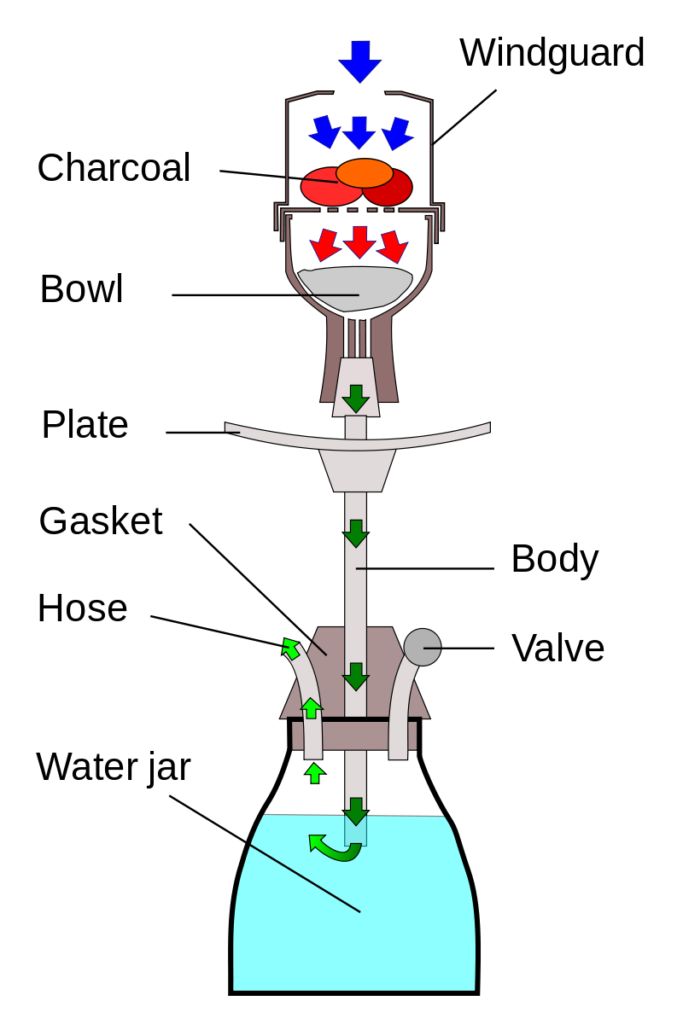
Operation of Hookah
How to operate hookah
The jar at the bottom of the hookah is filled with water sufficient to submerge a few centimeters of the body tube, which is sealed tightly to it. Deeper water will only increase the inhalation force needed to use it. Tobacco or tobacco-free molasses are placed inside the bowl at the top of the hookah. Often the bowl is covered with perforated tin foil or a metal screen and coal placed on top. The foil or screen separates the coal and the tobacco, with the foil and the tobacco reaching maximum temperatures of 450 and 130 degrees Celsius respectively.
These temperatures are too low to sustain combustion and considerably lower than the 900 degrees Celsius found in cigarettes.A larger fraction of the smoke condensates of the hookah are produced by simple distillation rather than by pyrolysis and combustion, and as a result, would tend to carry considerably less of the pyrosynthesized compounds found in cigarette smoke.
As a result of suction through the hose, a vacuum is created in the headspace of the water bowl sufficient to overcome the small static head of the water above the inlet pipe, causing the smoke to bubble into the bowl. At the same time, air is drawn over and heated by the coals.
It then passes through the tobacco mixture where due to hot air convection and thermal conduction from the coal, the mainstream aerosol is produced. The vapor is passed down through the body tube that extends into the water in the jar. It bubbles up through the water, losing heat, and fills the top part of the jar, to which the hose is attached.
When a user inhales from the hose, smoke passes into the lungs, and the change in pressure in the jar pulls more air through the charcoal, continuing the process. Vapour that has collected in the bowl above the waterline may be exhausted through a purge valve, if present. This one-way valve is opened by the positive pressure created from gently blowing into the hose.
Consumable items of Hookah
- Mu‘assel
Tobacco or Mu‘assel (Arabic: معسل, which means “honeyed”), also sometimes called Shisha in places where it does not refer to the Hookah itself, is a syrupy tobacco mix with molasses and vegetable glycerol as moisturizer and specific flavors added to it. Typical flavors of mu‘assel include apple, grape, guava, lemon, mint, as well as many other fruit-based mixes. Non-tobacco-based mu’assel is also available in certain areas where tobacco smoking is not allowed.

The flavors of Mu’assel include fruit, herb and mixed flavors. Fruit flavors include: apple, coconut, blueberry, lemon, watermelon, orange, cherry, banana, mango, pineapple, golden apple, strawberry, banana, apricot, grape, pineapple, watertight peach and cantaloupe. Herbaceous flavors include: rose, cinnamon, vanilla, fennel, cardamom, etc. Mixed flavors: coffee, cocktail, Coke, cappuccino, etc. You can also mix a variety of flavors according to your personal preference. You can also add some apple juice, sour cherry juice, grape juice, orange juice, lemon juice, pomegranate juice or rose oil, or even wine to the water in the bong.
- Charcoal
Charcoal is the source of energy to produce heat that will be transferred to the tobacco inside the bowl. Since the glycerol is used to moisturize the tobacco, then to produce smoke, the charcoal should be able to generate heat above the boiling point of glycerol that is 290 °C. Therefore, charcoal for hookah smoking must be hard, high density, easy to ignite, and burn longer with persistent heat
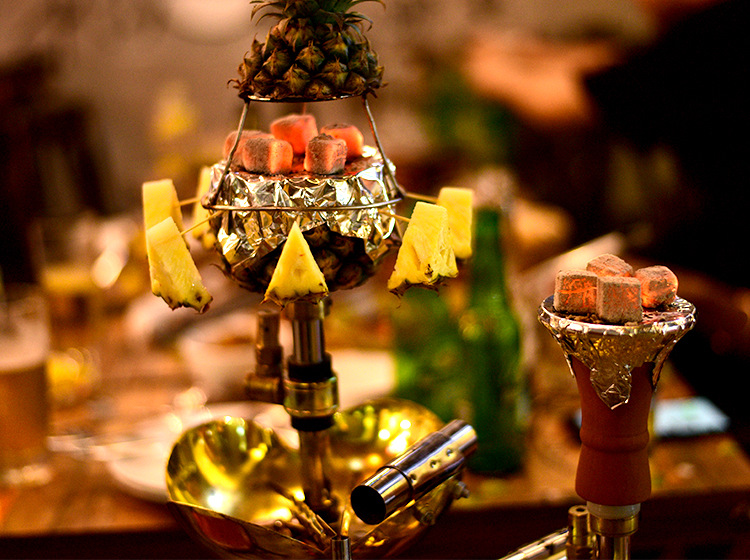
- Foil
Put a piece of hookah foil, wrap it around the bowl’s top and make small holes in a cylindrical fashion with your poker. When you finish, attach the hookah bowl to the stem, and don’t forget to use a rubber grommet to ensure that it sits air tight.
Usually the hookah last 45 minutes to 1 hour, then you need to reload the Mu‘assel and use a new piece of hookah foil.
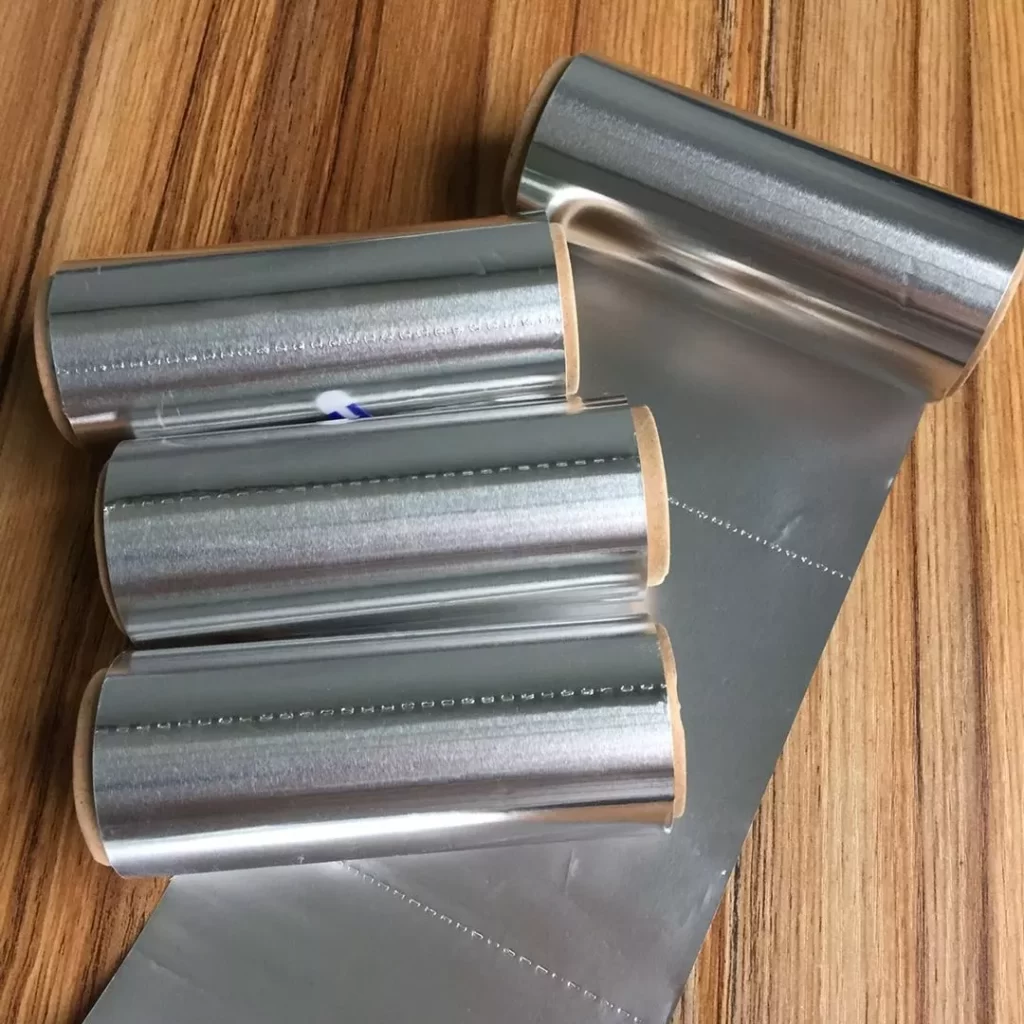
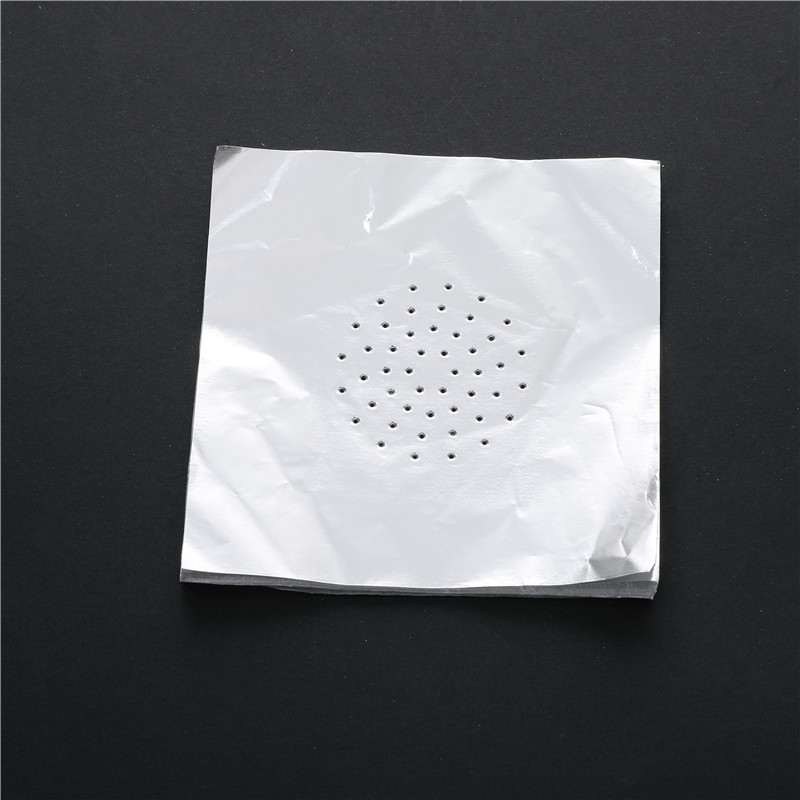
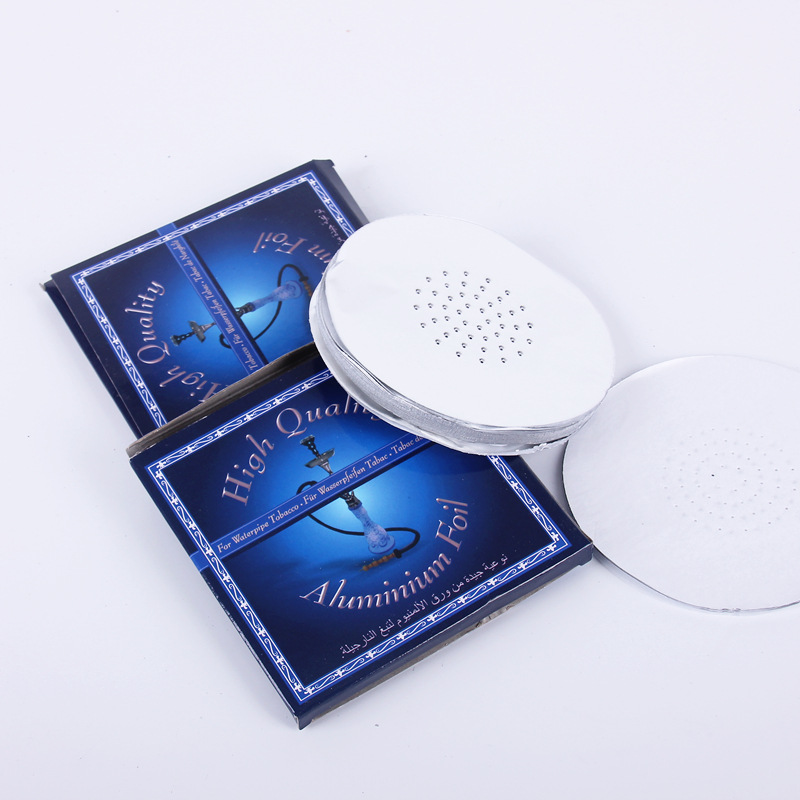
Want to know more?
Send us a message if you have any questions or request a quote. I will reply within 24 hours.
- +86 18906431372(WhatsApp/Wechat)
- [email protected]
If you do not mind, please do leave your phone number, because it is easier to get in touch with you.
If you do not receive my reply in time, please check the spam box, because sometimes my reply is there.
If your needs is urgent, please contact me directly on WeChat or Whatsapp.
